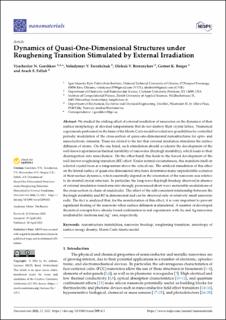Please use this identifier to cite or link to this item:
https://doi.org/10.21256/zhaw-24880Full metadata record
| DC Field | Value | Language |
|---|---|---|
| dc.contributor.author | Gorshkov, Vyacheslav N. | - |
| dc.contributor.author | Tereshchuk, Volodymyr V. | - |
| dc.contributor.author | Bereznykov, Oleksii V. | - |
| dc.contributor.author | Boiger, Gernot K. | - |
| dc.contributor.author | Fallah, Arash S. | - |
| dc.date.accessioned | 2022-04-28T09:27:06Z | - |
| dc.date.available | 2022-04-28T09:27:06Z | - |
| dc.date.issued | 2022-04 | - |
| dc.identifier.issn | 2079-4991 | de_CH |
| dc.identifier.uri | https://digitalcollection.zhaw.ch/handle/11475/24880 | - |
| dc.description.abstract | We studied the striking effect of external irradiation of nanowires on the dynamics of their surface morphology at elevated temperatures that do not destroy their crystal lattice. Numerical experiments performed on the basis of the Monte Carlo model revealed new possibilities for controlled periodic modulation of the cross-section of quasi-one-dimensional nanostructures for opto- and nanoelectronic elements. These are related to the fact that external irradiation stimulates the surface diffusion of atoms. On the one hand, such stimulation should accelerate the development of the well-known spontaneous thermal instability of nanowires (Rayleigh instability), which leads to their disintegration into nanoclusters. On the other hand, this leads to the forced development of the well-known roughening transition (RT) effect. Under normal circumstances, this manifests itself on selected crystal faces at a temperature above the critical one. The artificial stimulation of this effect on the lateral surface of quasi-one-dimensional structures determines many unpredictable scenarios of their surface dynamics, which essentially depend on the orientation of the nanowire axis relative to its internal crystal structure. In particular, the long-wave Rayleigh breakup observed in absence of external irradiation transforms into strongly pronounced short-wave metastable modulations of the cross-section (a chain of unduloids). The effect of the self-consistent relationship between the Rayleigh instability and RT is dimensional and can be observed only at relatively small nanowire radii. The fact is analyzed that, for the manifestation of this effect, it is very important to prevent significant heating of the nanowire when surface diffusion is stimulated. A number of developed theoretical concepts have already found confirmation in real experiments with Au and Ag nanowires irradiated by electrons and Ag+ ions, respectively. | de_CH |
| dc.language.iso | en | de_CH |
| dc.publisher | MDPI | de_CH |
| dc.relation.ispartof | Nanomaterials | de_CH |
| dc.rights | http://creativecommons.org/licenses/by/4.0/ | de_CH |
| dc.subject | Acoustic materials | de_CH |
| dc.subject | Digital material design | de_CH |
| dc.subject | Multiphysics | de_CH |
| dc.subject | Computational physics | de_CH |
| dc.subject | Nanostructure | de_CH |
| dc.subject | Nanostructure instabilities | de_CH |
| dc.subject | Monte Carlo kinetic model | de_CH |
| dc.subject | Nanowire breakup | de_CH |
| dc.subject.ddc | 530: Physik | de_CH |
| dc.title | Dynamics of quasi-one-dimensional structures under roughening transition stimulated by external irradiation | de_CH |
| dc.type | Beitrag in wissenschaftlicher Zeitschrift | de_CH |
| dcterms.type | Text | de_CH |
| zhaw.departement | School of Engineering | de_CH |
| zhaw.organisationalunit | Institute of Computational Physics (ICP) | de_CH |
| dc.identifier.doi | 10.3390/nano12091411 | de_CH |
| dc.identifier.doi | 10.21256/zhaw-24880 | - |
| zhaw.funding.eu | No | de_CH |
| zhaw.issue | 9 | de_CH |
| zhaw.originated.zhaw | Yes | de_CH |
| zhaw.pages.start | 1411 | de_CH |
| zhaw.publication.status | publishedVersion | de_CH |
| zhaw.volume | 12 | de_CH |
| zhaw.publication.review | Peer review (Publikation) | de_CH |
| zhaw.funding.snf | 206111 | de_CH |
| zhaw.webfeed | Multiphysics Modeling | de_CH |
| zhaw.author.additional | No | de_CH |
| zhaw.display.portrait | Yes | de_CH |
| Appears in collections: | Publikationen School of Engineering | |
Files in This Item:
| File | Description | Size | Format | |
|---|---|---|---|---|
| 2022_Gorshkov-etal_Dynamics-quasi-one-dimensional-structures.pdf | 6.64 MB | Adobe PDF |  View/Open |
Show simple item record
Gorshkov, V. N., Tereshchuk, V. V., Bereznykov, O. V., Boiger, G. K., & Fallah, A. S. (2022). Dynamics of quasi-one-dimensional structures under roughening transition stimulated by external irradiation. Nanomaterials, 12(9), 1411. https://doi.org/10.3390/nano12091411
Gorshkov, V.N. et al. (2022) ‘Dynamics of quasi-one-dimensional structures under roughening transition stimulated by external irradiation’, Nanomaterials, 12(9), p. 1411. Available at: https://doi.org/10.3390/nano12091411.
V. N. Gorshkov, V. V. Tereshchuk, O. V. Bereznykov, G. K. Boiger, and A. S. Fallah, “Dynamics of quasi-one-dimensional structures under roughening transition stimulated by external irradiation,” Nanomaterials, vol. 12, no. 9, p. 1411, Apr. 2022, doi: 10.3390/nano12091411.
GORSHKOV, Vyacheslav N., Volodymyr V. TERESHCHUK, Oleksii V. BEREZNYKOV, Gernot K. BOIGER und Arash S. FALLAH, 2022. Dynamics of quasi-one-dimensional structures under roughening transition stimulated by external irradiation. Nanomaterials. April 2022. Bd. 12, Nr. 9, S. 1411. DOI 10.3390/nano12091411
Gorshkov, Vyacheslav N., Volodymyr V. Tereshchuk, Oleksii V. Bereznykov, Gernot K. Boiger, and Arash S. Fallah. 2022. “Dynamics of Quasi-One-Dimensional Structures under Roughening Transition Stimulated by External Irradiation.” Nanomaterials 12 (9): 1411. https://doi.org/10.3390/nano12091411.
Gorshkov, Vyacheslav N., et al. “Dynamics of Quasi-One-Dimensional Structures under Roughening Transition Stimulated by External Irradiation.” Nanomaterials, vol. 12, no. 9, Apr. 2022, p. 1411, https://doi.org/10.3390/nano12091411.
Items in DSpace are protected by copyright, with all rights reserved, unless otherwise indicated.